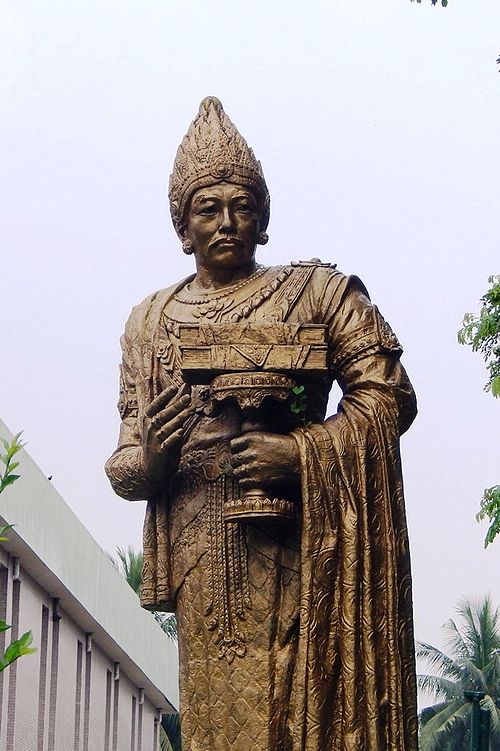King Anawrahta: The Founder of the Burmese Empire

🕰️ Introduction
Keyphrase: “King Anawrahta biography” | “Founder of Bagan Kingdom” | “History of Myanmar kings”
Long before the modern nation of Myanmar came to be, there lived a visionary king who turned a land of scattered tribes into one of Southeast Asia’s most powerful empires. His name was King Anawrahta — a warrior, a reformer, and a believer who forever changed the destiny of Myanmar.
👶 Early Life and Birth (1014–1038)
Keyphrase: “Anawrahta early life” | “Anawrahta childhood”
Anawrahta was born in 1014 AD in Pagan (Bagan), a small kingdom in central Burma. He was the son of King Kunhsaw Kyaunghpyu and Queen Myauk Pyinthe.
When Anawrahta was a child, the Pagan throne was unstable. His father was dethroned by two stepbrothers — Sokkate and Kyiso. This early political turmoil shaped young Anawrahta’s understanding of power and leadership.
Growing up, he learned the art of warfare, archery, and statecraft. He was known for his courage and ambition even as a teenager.
⚔️ Rise to Power (1044 AD)
Keyphrase: “Anawrahta ascension to throne” | “Bagan dynasty history”
When Sokkate became king, his harsh rule caused unrest. Anawrahta challenged him to a duel of honor — and in 1044 AD, he killed Sokkate in battle, taking the throne at the age of 30.
This marked the beginning of the Bagan Dynasty, which would last over 200 years and unify the regions that now form Myanmar.
🕋 The Unification of Myanmar
Keyphrase: “Anawrahta unites Myanmar” | “Pagan Empire formation”
After his coronation, Anawrahta focused on uniting the fragmented states of Upper and Lower Burma.
He defeated rival tribes and kingdoms such as Thaton, Pyay (Prome), and Arakan, bringing them under Pagan rule.
He introduced a centralized administration, strengthened the army, and built a strong network of irrigation canals to improve agriculture — turning Bagan into a flourishing capital.
🛕 Conversion to Theravada Buddhism
Keyphrase: “Anawrahta and Theravada Buddhism” | “Buddhism in Myanmar history”
Anawrahta’s most significant legacy wasn’t just his empire — it was his faith.
Initially, Pagan practiced a mix of Hinduism, animism, and Mahayana Buddhism. However, after meeting a monk named Shin Arahan, Anawrahta converted to Theravada Buddhism, which emphasized purity and compassion.
He sent envoys to the Thaton Kingdom to request Buddhist scriptures (Tripitaka). When King Manuha of Thaton refused, Anawrahta invaded Thaton in 1057 AD, captured the city, and brought thousands of monks and scriptures back to Pagan.
This act transformed Pagan into a great Buddhist center — filled with temples, monasteries, and learning institutions.
🏗️ Building the City of Temples – Bagan
Keyphrase: “Bagan temples history” | “Anawrahta architecture”
Under Anawrahta’s reign, Bagan became one of the most beautiful cities in Asia.
He commissioned temples such as:
Shwezigon Pagoda – symbol of the new faith in Theravada Buddhism.
Lawkananda Pagoda – built on the Irrawaddy River bank.
Pitaka Taik – the library to house Buddhist scriptures.
These monuments still stand today as a testament to his devotion and vision.
⚔️ Military Expansion and Diplomacy
Keyphrase: “Anawrahta military campaigns” | “Myanmar ancient wars”
Anawrahta was not just a spiritual ruler; he was also a strong military strategist.
He extended his empire’s influence to Thailand (Sukhothai region), Laos, and parts of China’s Yunnan province.
However, instead of endless conquest, he preferred stability and trade. He established alliances with neighboring kingdoms and exchanged culture, religion, and commerce.
💬 Personal Life and Character
Keyphrase: “Anawrahta personal life” | “Anawrahta leadership qualities”
Historical accounts describe Anawrahta as brave, intelligent, and deeply religious.
He treated his people with fairness and encouraged education. He was also known for his humility — often visiting pagodas on foot to make offerings.
Despite being a conqueror, he sought peace and harmony for his people.
⚰️ Death and Legacy (1077 AD)
Keyphrase: “Anawrahta death” | “Anawrahta legacy”
King Anawrahta died in 1077 AD under mysterious circumstances — some say he was killed by a wild buffalo during a journey; others believe it was an assassination.
He was succeeded by his son, King Sawlu, who continued his work but never matched his greatness.
Even after his death, Anawrahta’s influence endured. His efforts laid the foundation of Burmese culture, language, and Buddhism that still defines Myanmar a thousand years later.
🌄 Conclusion
Keyphrase: “Legacy of King Anawrahta” | “History of Myanmar kings”
King Anawrahta was more than a warrior king — he was a visionary founder who gave Myanmar its identity.
From uniting warring tribes to establishing Buddhism as the heart of the nation, his story is one of ambition, wisdom, and faith that continues to inspire generations
